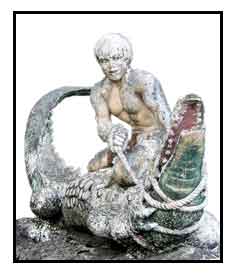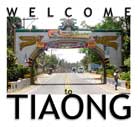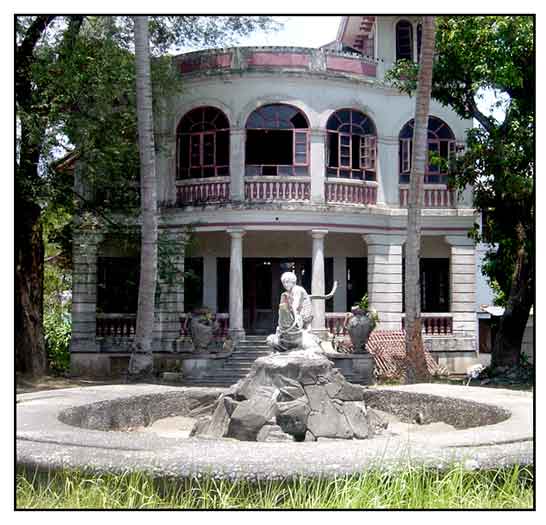
It is the oldest house in Tiaong, but long abandoned and decaying
from disuse, a relic historied with elements of a colonial past and
a war-time occupation by the Japanese, rebuilt from the damage wrought
by the bombardment during the American liberation. Now it stands,
a dying landmark, prey to vandals and petty thieves stripping it of
wires, doors and metal scraps, lovers seeking a trysting place, treasure
hunters still in search of Japanese caches of treasures.
The imposing stone structure with the central
garden sculpture built in 1927, is a testament of the efforts and
conceptions of two men: Isidro Herrera and an architect of great renown
in his time, Tomas Mapua.
The garden sculpture of Elias - in the middle
of the horseshoe-shaped pool - was inspired and drawn from Jose Rizal's
El Filibusterismo. The sculpture of the half-naked Elias, in his brawn
and bravado, subduing the crocodile, holds frozen in time the smoldering
rage of the filibusters against the Spanish dictatorship.
Alas, for some, the crocodile has also stood as
a symbol of the bourgeosie's cruel greed, and Elias, the common man
that takes up the struggle against the collective burgis.
HISTORICAL
NOTE: The house was built in 1927 to Thomas Mapua's architectural
design. The back part of the house was damaged by the bombings at
the end of the Japanese occupation; repairs and additions were done
in 1950 by C. Gonzales, a Candelaria architect. The facade persists
of Thomas Mapua's original architectural design, including the Elias
sculpture and the garden's other concrete structures.
The Ghosts Within
Many say it's haunted. Headless
soldiers in Japanese uniforms, helmets in hand. An elderly couple
in regal white slowly descending the circular steps, completing the
descent as a headless apparition. The rattling of doorknobs. Doors
that suddenly refuse to open. The sound of shackled walking and the
dragging of chains. The heavy cold air that wraps around the intruding
guests.
Many have
tried to brave through a night. My brother's karate group, brown and
black belters, visiting for a weekend of instructions and exhibition
of their martial art skills. Another, a nephew and his barkada,
aware of the ghosts, intent to tease and draw them out of their ethereal
habitats, their nerves augmented by alcohol and fraternity. None lasted
to the midnight hour, skedaddling back to Manila, their machismo bruised
and tempered.
Some believe
the spirits have claimed the space and have joined together to hinder
and stall all efforts to sell or demolish it.
Recent
caretakers continue to tell of an old lady in the traditional ghostly
garb of white, her white hair loose on her shoulders, lingering around
the rooms, with a penchant for conversing with their little children,
bringing them to giggles and laughter.
Its hauntedness
is kept alive by the townfolk – stories from the diminishing
number of old-timers who remember the olden days and a constant replenishing
source of sightings from passers-by as they steal glances at the framed
glass windows and doors sometimes catching shadowy forms moving about
– stories that resuscitate as the October days march into Halloween
night.
Some of us still suffer a connection with
it, a common bond with a shared past, hoping, searching for a
way to save it. And I, one of them. I was born in that house,
haunting me with memories of the halcyon days of a childhood
wrapped in trimmings of provincial gentry, fondly remembered,
not for its previleges, but for the wonderful windows that opened,
that took us to ricelands, the coconut plantations, the hills
and rivers of rural Tiaong, the warmth of its people, the color
of their endless stories and mythologies. . . and inevitably,
the reason to come back.
Yes. . . the old house, i visit it frequently. It
has been stripped empty; the rooms now open, mere joists and beams.
Still, easily, when I close my eyes, the sounds of a bygone past engulf
and sometimes, a cold air gently embraces me. Yes, that old stone
house, it is both that. Haunted. . . and haunting.




